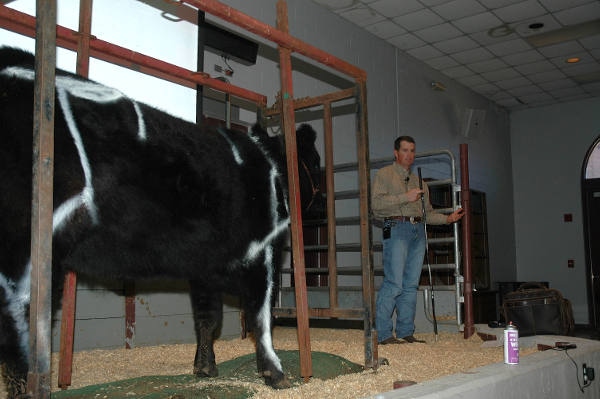January 31, 2013

Purchasing a bull can be a difficult and sometimes expensive proposition for a beef cattle producer. However, ranchers got an inside look at how to overcome some of these challenges at a recent workshop held in College Station by the Texas A&M AgriLife Extension Service.
“We have a lot of breeds of cattle in the U.S. and different cattle work well in different environments,” said Dr. Jason Cleere, AgriLife Extension beef cattle specialist, who led the workshop with Dr. Jason Banta, AgriLife Extension beef cattle specialist at Overton.
Approximately 50 producers attended the workshop, and organizers said the strong numbers will lead to organizing a fall workshop. Cleere discussed the different types of retail beef available to consumers – prime, choice and select – which is more prevalent at grocery stores, he said.
When selecting a bull, Cleere said, “I encourage you to look at the big picture.”
Fertility and potential calf birth weights are just a few of several points to study.
“Genetic potential for growth and price per pound are other things to consider,” he said.
Cleere advised producers to avoid buying bulls with an unknown background. He said producers should consider buying from a breeder who specializes in producing quality genetics for commercial operations.
Next, consider how much you are willing to pay for a bull.
“How much do I spend? I like to turn this around and say how much do I invest in a bull?” Cleere said.
Half of the genetics from a cow herd will be generated from the female and the other half from the bull.
“That bull is over half of your calf crop,” Cleere said. “Folks spend $1,500 to $2,000 on replacement females and then gripe about spending $1,500 on a bull. He makes a huge impact on the genetics of a commercial cow herd.”
He said breed type, individual performance data, pedigree and visual appraisal are some of the items to consider when purchasing a bull.
“You are not going to use all of it during selection, (just) those that apply to the goals of your operation,” he said.
Expected Progeny Differences or EPDs are also used in bull selection. These are an estimated measure of the genetic impact of a parent on the offspring. EPDs provide an average number for birth weight, yearling weight and milk weight for an animal and vary depending on breed type.
Another point to consider is what is the best breed type?
“That’s the million dollar question,” Cleere said. “Because we don’t have a controlled environment in Texas, we have different types of cattle that are best suited for different parts of the state.”
Those areas include the Trans-Pecos, High Plains, Central Texas, East Texas, Gulf Coast and South Texas, he said.
“There are different types and kinds of cattle as we move across the state,” Cleere said. “We end up with different types of calves.”
Heterosis or hybrid vigor also plays a big role in cattle selection for Texas ranchers, he added.
“The more harsh your environmental conditions are, the more important heterosis is,” Cleere said. “Hybrid vigor is very important.”
You May Also Like




